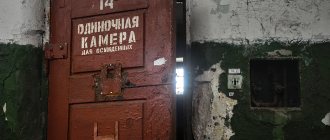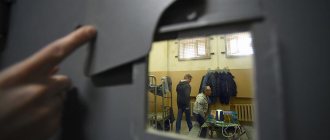The walls of the Vladimir Central keep no less secrets than Butyrka and “Crosses”. Something happened in the cells of this prison that they preferred to forget about for many years.
They also forgot about many famous people who were in the dungeons of the Vladimir Central. Meanwhile, even a well-known surname and relationship with the highest ranks of the USSR could not save him from imprisonment in this prison. So who was the most famous prisoner, and why did Mikhail Krug write a song about prison?
To Siberia - through the Vladimir Central
In Tsarist Russia, most criminals were sent to prisons in Siberia. The journey there took many days, and not all convicts survived to the place where they served their sentences. Therefore, Empress Catherine II ordered the construction of a transit prison on the Vladimir highway leading to Siberia. The city of Vladimir was chosen as its location. It was there that the Vladimir Central was built in 1783. Moreover, its construction itself was shrouded in mystery.
The Empress ordered the construction of a prison according to a special plan. According to him, there was a real labyrinth inside. Sometimes even the builders themselves got lost in the endless corridors and dead ends. Catherine II's idea was this: if a prisoner escapes from his cell, he will get lost. By the way, that’s what happened. Rare escapees from their cells managed to find a way to freedom. But most didn't even try. The conditions in this transit prison were not bad.
"Vladimir Central" today
The Vladimir Central prison continues to operate to this day. Particularly dangerous criminals serve their sentences there.
Today “Vladimir Central” bears the official name of FKU T-2 of the Federal Penitentiary Service of Russia for the Vladimir Region.
According to the latest data, the prison contains about 1 thousand convicts out of 1,221 people, the maximum allowed by established standards. Among them, only 15% of those convicted are serving sentences under a court sentence.
The remaining category of prisoners are malicious violators of the order of serving sentences in correctional institutions. In addition, the prison has a special block for those who received a life sentence.
Due to the fact that repeat offenders are kept in prison, criminal concepts are clearly manifested in it, which are sacredly respected by all participants. In the Vladimir Central, various attempts at riots, hunger strikes and other provocations of convicts are not uncommon.
The regime of detention in the Vladimir Central
In 2021, prison No. 2 in Vladimir is a complex of 4 buildings that house criminals who have committed serious or especially serious criminal acts.
In each prison building there are special rooms:
- In the first building there is a sector for life prisoners;
- In the second building there is a treatment block;
- In the third building there are cells for convicts;
- In the fourth building there is a pre-trial detention center and a reception department.
Thus, it turns out that a larger number of convicts are kept in the third building . There are cells designed for 2-12 people, measuring 4 by 6 or 6 by 6 meters.
Today, the prison regime has improved significantly compared to Soviet times. Ventilation appeared in the cells, their walls were painted in light colors. Each cell has a TV, refrigerator and radio.
In 1995, the St. Nicholas Church was opened in one of the prison cells. Convicts have the right to visit him. In addition, they can order books from the library, discuss their lives with a psychologist, and visit the computer room.
The library, by the way, has about 25 thousand volumes, where everyone can find literature that suits their interests. A dentist, a TB specialist and a venereologist are constantly working in the treatment block; there is a special department for HIV-infected prisoners.
All convicts, as it should be in any prison, are busy most of the time with work. The central has its own production site, where prisoners create mattresses, workwear and sports equipment. The prison bakery supplies all correctional institutions in the region with products.
Meat is not only for major holidays
Prisoners, and especially sick ones, were well kept in the Vladimir Central. They just preferred not to talk about it. Such secrecy was justified. If prisoners in other prisons heard about the “sweet life” in the central prison, they would certainly want it in their own. And this could not be allowed. So they hid the diet of prisoners of the Vladimir Central as a great secret.
And there was something to hide. The Vladimir transit prison had its own vegetable garden. Prisoners were regularly given fresh vegetables and meat. The patients received special nutrition. Every day they were given veal dishes for lunch, and meat broth and cutlets for dinner. The prisoners were not deprived of sweets either. They were given jelly every day, and sometimes sweet pastries.
There is even a photograph of Mikhail Frunze sitting in the Vladimirka. In it he looks very healthy and happy with life. By the way, it was Frunze who almost escaped from the Vladimir Central Prison. He failed to escape from the prison itself, but he escaped from the local courthouse. And, by the way, he was not the only known secret prisoner of the central.
New in blogs
Ilya Arkhipov Vladimir Central. Stalin's son and the spy Powers sat here https://www.kp.ru/daily/26126/3018769/
The legendary Vladimir Central prison celebrates its anniversary [photo] 230 years ago, the construction of a “workhouse” - in modern parlance, a temporary detention center - was completed on the notorious convict road - “Vladimirka”. On August 15, 1783, according to the old style (August 31, according to the new style), the future “VIP prison”, built by the personal decree of Catherine the Second, “hospitably” opened its doors... mainly for entry, and not for exit.
At first they were imprisoned here for petty crimes, and until the beginning of the 20th century the regime was relatively mild - walks, visits, transfers. Then revolutionaries began to be imprisoned in the “prison castle”, and from here the horrors of Central began - punishment cells, cruelty of the guards, cruel executions.
Epochs and state policies changed, and with them, the prison’s residents: at different times, there were criminals, political prisoners, and war criminals.
They say it’s an honor to “sit” here. Photo: YAZININ Mikhail
CENTRAL - HE’S LIKE ALCATRAZ
“Prison 2,” as it is officially called, is associated not only with Mikhail Krug’s song, but also with a lot of legends. Very famous people sat here: the popularly beloved singer Lydia Ruslanova, actress Zoya Fedorova, part of the top of Nazi Germany, the head of Hitler's personal security Hans Rathenhuber, Soviet dissidents (for example, Vladimir Bukovsky and Natan Sharansky), and even a descendant of the Prophet Muhammad, arrested in 1938 in Samarkand as a foreign spy.
The main legend of Central is that it is supposedly the only prison in Russia from which no one escaped. The prison was originally built as a labyrinth, and even after getting out of the cell, the prisoner had little chance of finding a way out. Indeed, they tried hundreds of times - they dug tunnels, sawed off the gratings, bribed the guards. Officially, in the entire history of the prison there were two successful escapes; in the middle of the 20th century, the prisoners managed to drink through the bars. The first “runner” was caught after a month, the second after three. Ask: how is this possible, since they say that at the beginning of the 20th century, the future Soviet army commander Mikhail Frunze managed to escape from here? But this is just a myth. He succeeded in escaping, but from another building - the provincial court in Vladimir. He was tried for beating a police officer. Frunze also tried to escape from Central, but a vigilant guard turned him in.
HOW STALIN MADE A TROLLEY
The most famous prisoner here can be considered the convicted Vasily Pavlovich Vasiliev. Under this name was General Vasily Stalin, the leader’s son, arrested in April 1953. He was given 8 years for embezzlement. Usually such prisoners became “iron masks”: they sat under numbers, they were never seen by other prisoners, and very few of the guards. Stalin was not assigned a number and special conditions of imprisonment were created: in his cell there was the only radio point in the entire prison, and fresh flowers were regularly brought here. “Vasiliev” worked in mechanical workshops and clearly did not do slack: according to his drawings, a convenient cart was assembled here, on which gruel is still transported from the dining room to the buildings. Soon they promise to “write off” the cart to the prison museum.
Pilot Garry Powers, whose U-2 spy plane was shot down on May 1, 1960 near Sverdlovsk, served his sentence here. In prison, an American learned to knit rugs. Irony of fate: Powers' cellmate was the developer of the radar station of the Soviet air defense system, with the help of which the American's plane was shot down (radio designer Georgy Uger moved to). After 1.5 years, Powers was exchanged for Soviet intelligence officer Rudolf Abel.
There is also a museum in the prison. Photo: Mikhail YAZYNIN
TO ALL LAWNESS LAWNESS
For the 1980 Olympics, all political prisoners are transported inland, and Central becomes a purely criminal prison, the “patrimony” of thieves in law - at one time there were 26 of them here at once! At first, people lived here “according to rules,” but the criminal lawlessness of the 90s that reigned in the country also affected Central. The authorities tried to exercise power in prison by staging hunger strikes and throwing crap at human rights activists. Power was shared by a dozen national groups, even homemade weapons were divided along national lines: Tatar groups made triangular pins, Russians made double-edged sharpening points, Caucasians made rounded peaks. Prisoners were taken for walks at gunpoint.
But there were no loud scandals associated with the prison, and soon the prisoners themselves were tired of the chaos. Over the past 20 years, Central has been considered a very “quiet” prison.
TO THE HOSPITAL!
Getting to the hospital is the dream of every Central resident. What did they do for this purpose! In the prison museum there is a whole showcase of objects swallowed by prisoners. For example, crosses made of wire: the ends were stuck together with bread crumbs and swallowed, and the cross opened in the stomach. Among the most terrible stories: one prisoner cut off his own ear, and after the ear was sewn on, he cut off the second one. Another nailed the scrotum to a board. A third swallowed a full set of dominoes.
By the way, the doctors at the prison hospital unanimously say that prisoners are able to recover from injuries that would be fatal in the wild. Medicine does not know the reasons.
Photo: Mikhail YAZYNIN
TO PRISON - WITH A TRAVEL
In 2006, one of the Moscow companies offered the “One Day in Prison” tour. Guests of the Central were dressed in robes, fingerprinted, handcuffed, and photographed with a number (as a souvenir). Rough treatment, gruel and walks in the courtyard were included in the price of the tour. Tourism here did not flourish for long: the high authorities closed their shop.
BY THE WAY
The prison has its own temple - it was opened in the cell where the writer Daniil Andreev created his “Rose of the World”. At one time, a difficult priest, Subdeacon Pavel, served here. He allegedly asked to go to prison himself, confessing to several murders. It turned out that everything said was true. Local chaplains are all prisoners from Central, and do not allow anyone else to serve. In 2003, the icons in the temple, which were not painted by prisoners, were myrrhized.
There is also a museum. It contains ancient instruments of punishment, documents, and many handicrafts made by prisoners (chess in the form of various figures is especially popular).
HELP "KP"
The Vladimir Central today is a complex of four buildings where over a thousand people are serving sentences for serious and especially serious crimes, including 15 “lifers.” Terms from 15 to 30 years.
There are cells for 2-12 people, there are no bunk beds left: the prison is not overcrowded and is being modernized according to European standards. Toilets instead of “bowls”, TVs and radios, and new bars on the windows that let in more light. This summer, air conditioning was installed in the cells. There is even a computer legal aid center. They say it’s an honor to “sit” here.
Prisoners' walks traditionally take place in the courtyard - a large cell with bars instead of a ceiling. It is believed that it was in Central that the expression “checkered sky” was born.
See our PHOTO GALLERY.
Secret prisoners of the Vladimir transit prison
In Soviet times, people with big names ended up in the Vladimir Central. They just preferred to remain silent about this. Two famous artists also found themselves behind bars in this prison. Ballerina Zoya Fedorova and singer Lidiya Ruslanova received prison sentences there. It turns out that even fame couldn’t save me.
And even kinship with the leader of the peoples did not give a chance not to thunder into the central one. Relatives of Stalin's wife, Evgenia and Anna Alliluyeva, ended up in this prison. And Konstantin Ordzhonikidze, the People’s Commissar’s brother, was also sitting there. But he was far from the most famous relative who ended up in Vladimirka.
Where can you find out about the history of the prison?
The composition of the same name by Mikhail Krug has been maintaining citizens’ interest in one of the oldest Russian prisons for decades. The question of where the Vladimir Central is located is asked by all guests of the city, without exception. To satisfy the interest of the curious, the institution has had a permanent exhibition since 1996. The idea of creating a museum at the Vladimir Central belonged to prison doctor Elena Nikolaevna Butova.
With the idea of organizing a permanent exhibition within the walls of the institution, a caring woman turned to the highest authorities, justifying the importance of the project with the words “We had so many outstanding people.” The initiative found government support. Research workers from the Vladimir-Suzdal Museum-Reserve Vitaly Gurinovich and Nikolai Morozov helped organize the exhibition.
The museum is located in the same place where the Vladimir Central itself is located - in the city of Vladimir, st. Bolshaya Nizhegorodskaya, 67, in a former industrial building on the second floor. The exhibition is open all year round, from 8:00 to 17:00.
For those who are interested in the history of the prison, but do not have the opportunity to visit the museum in Vladimir, we invite you to familiarize yourself with the main milestones in the development of the Vladimir Central from Catherine’s times to the present day.










